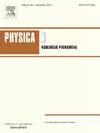IF 2.7
3区 数学
Q1 MATHEMATICS, APPLIED
引用次数: 0
摘要
当粘度较低的流体在海尔-肖电池的狭窄间隙中置换粘度较高的流体时,就会产生萨夫曼-泰勒(或粘指)不稳定性。流体-流体界面的动力学通常由一组间隙平均方程来描述,包括达西定律和流体不可压缩性,并辅以压力跃迁(杨-拉普拉斯方程)和运动边界条件。在过去的二十年里,多个研究小组研究了粘性法向应力对 Young-Laplace 方程的影响,以及径向指压的发展。然而,在这些研究中,粘性法向应力的贡献是通过在压力跃变条件中插入一个合法的二维项来实现的。因此,沿垂直于赫勒-肖板方向的流体速度的显著变化被忽略了。根据赫勒-肖流动近似,并类似于达西定律的推导,我们通过对三维粘性应力张量进行间隙平均计算,在杨-拉普拉斯方程中引入粘性应力。然后,我们计算了这些间隙平均粘性应力在界面扰动演化的线性稳定性和早期非线性分析中的贡献。我们的研究结果表明,这种方法会导致手指生长速度减慢,并加剧典型的尖端分裂事件。本文章由计算机程序翻译,如有差异,请以英文原文为准。
Action of viscous stresses on the Young–Laplace equation in Hele-Shaw flows: A gap-averaged calculation
The Saffman–Taylor (or, viscous fingering) instability arises when a less viscous fluid displaces a more viscous one in the narrow gap of a Hele-Shaw cell. The dynamics of the fluid–fluid interface is usually described by a set of gap-averaged equations, including Darcy’s law and fluid incompressibily, supported by the pressure jump (Young–Laplace equation) and kinematic boundary conditions. Over the past two decades, various research groups have studied the influence of viscous normal stresses on the Young–Laplace equation on the development of radial fingering. However, in these works, the contribution of viscous normal stresses is included through the insertion of a legitimately two-dimensional term into the pressure jump condition. As a result, the significant variation of the fluid velocity along the direction perpendicular to the Hele-Shaw plates is neglected. In line with Hele-Shaw flow approximations, and analogous to the derivation of Darcy’s law, we introduce viscous stresses in the Young–Laplace equation through a gap-averaged calculation of the three-dimensional viscous stress tensor. We then compute the contributions of these gap-averaged viscous stresses in both the linear stability and early nonlinear analyses of the interface perturbation evolution. Our findings indicate that this approach leads to a slowdown in finger growth, and an intensification of typical tip-splitting events.
求助全文
通过发布文献求助,成功后即可免费获取论文全文。
去求助
来源期刊

Physica D: Nonlinear Phenomena
物理-物理:数学物理
CiteScore
7.30
自引率
7.50%
发文量
213
审稿时长
65 days
期刊介绍:
Physica D (Nonlinear Phenomena) publishes research and review articles reporting on experimental and theoretical works, techniques and ideas that advance the understanding of nonlinear phenomena. Topics encompass wave motion in physical, chemical and biological systems; physical or biological phenomena governed by nonlinear field equations, including hydrodynamics and turbulence; pattern formation and cooperative phenomena; instability, bifurcations, chaos, and space-time disorder; integrable/Hamiltonian systems; asymptotic analysis and, more generally, mathematical methods for nonlinear systems.
 求助内容:
求助内容: 应助结果提醒方式:
应助结果提醒方式:


